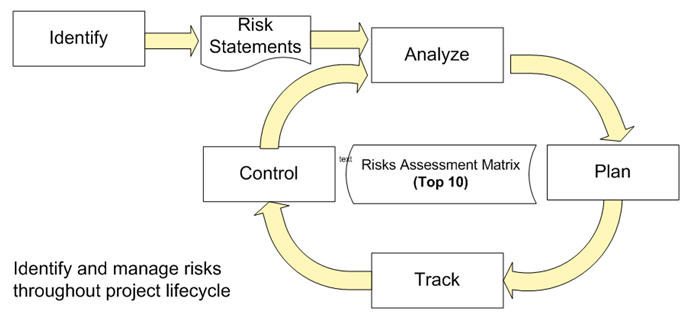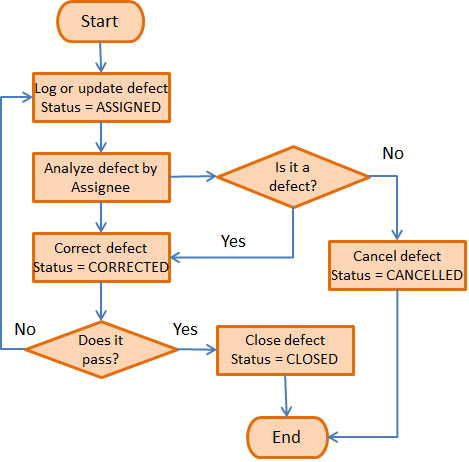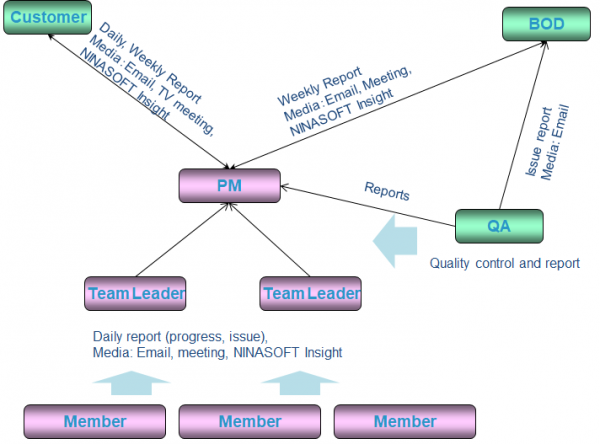Software Development Process
Ninasoft manages software projects quantitatively based on Quality Management System that includes a set of Process handbook, Process database, PCB, Process Asset and Tools. Almost projects are applying a complete life cycle for Estimation, Requirement, Design, Code, Test and Release for developing software projects, and we standardize it as a Software Development Process.
1. Estimation
2. Req Analysis
3. Design
4. Coding
5. Test
6. Release
Management model
In software development project, there are sometime uncertain events or conditions occurred and have harmful or negative effect on the project so that we need to manage them in order to minimize their impact on project. We call those events or conditions are project risks.

- Firstly, risks are identified from early phases of project and managed in NINASOFT Insight. And then they are analyzed and prioritized based on their impact and probability of risk occurrence.
- Plan: It is necessary to plan the risk mitigation actions to minimize the risk consequence and the contingency actions those should be carried out if risk occurs.
- Track: Periodically review and evaluate new risks:
- Status of risks with active mitigation actions
- Evaluate risk’s trigger by approaching due date in order to decide if to activate contingency actions.
- Identify new risks.
Model Review
In order to ensure the quality of products, project on track and usage effort in control, review activities should be planned and extensively carried out with defined process.

1. Plan for review
– Set Review Objective & Review metrics
– Select work products to be reviewed
– Identify Review type for every to-be-reviewed products
– Appoint Review Leaders and determine Reviewers
– Schedule for the reviews
2. Preparing for review
– Gather specification, standards, requirements associated to the work product to be reviewed
– Develop Review checklist, and necessary form/template
– Build the review package and deliver to the reviewers
– Provide training to reviewers in review process, using review checklist, tools, etc, as necessary
– Explain review objectives and the work product and associated information needed for the review
3. Preparing for review
– Gather specification, standards, requirements associated to the work product to be reviewed
– Develop Review checklist, and necessary form/template
– Build the review package and deliver to the reviewers
– Provide training to reviewers in review process, using review checklist, tools, etc, as necessary
– Explain review objectives and the work product and associated information needed for the review
4. Conduct review
– Conduct review individually
– Hold a group review meeting
5. Evaluating review result
– Consolidate the review report
– Evaluate the review result and make Conclusion: Pass or Review again
– Identify follow-up action taken to solve the issues
– Give recommendation for next review, if any
6. Follow up
– Communicate the review result to relevant people
– Correct the work product and get confirm with the Review Leader
– Implement follow up actions
Model Management Defect/Bug
Defect data is one of most important kinds of data used to analysis and evaluate the product quality and proposed improvement actions based root cause analysis of defect. For its importance, defects are managed in NINASOFT Insight tool with a defined standard process.

- Defects found during the review and test are logged into NINASOFT Insight and assigned to one project member as person in charge.
- The person in charge will analyze defect to understand root cause. For this purpose, appropriate techniques are employed such as Pareto, Cause-Effect Diagram, etc.
- Based on the root cause, Corrective & Preventive actions are initiated to close the particular defects and prevent their further occurrence.
- Reviewer/QA perform review and test again to ensure defect be fixed correctly or not.
Model Communication Flow
- Communication plan is drawn upon the very beginning to establish the standards for communication such as to how often, and at which levels the communication will occur
- Weekly communication with customer is the best practice of our projects since it is critical to the success of the projects. This real time communication ensures that issues are dealt with as they arise, and that the issues are addressed in an efficient and effective manner.
- Communication mechanism used include TV meetings, conference calls, Video conference, emails, instant messenger chat sessions.
- Moreover, NINASOFT Insight helps to improve communication among relevant parties of the project regardless of geographic boundaries.
- Customer can access to the system via Internet to review project status at real time

